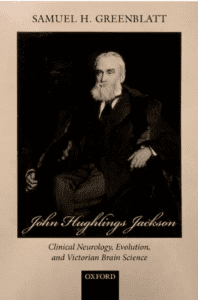Arpan K. Banerjee
Solihull, United Kingdom

Cover of John Hughlings Jackson: Clinical Neurology, Evolution and Victorian Brain Science by Samuel H. Greenblatt. Oxford University Press, 2022. ISBN 9780192897640.
John Hughlings Jackson is often considered to be the father of clinical neurology, although his contemporary in France, Jean-Martin Charcot, could also justifiably lay claim to that title. Both men made gigantic contributions in the latter half of the nineteenth century, a golden age of clinical neurology in which many neuroanatomical, neuropathological, and physiological advances were made. In that era, clinicians did not have the luxury of high-tech imaging devices such as CT scanners, which today have made the diagnosis of complex neurological conditions much easier. A history and clinical examination were the only means of localizing lesions and possibly making a diagnosis.
John Hughlings Jackson was born in 1835 in Yorkshire. He attended York Medical School, which closed in 1862 after the introduction of the regulatory Medical Act of 1858. He moved to London to further his career and qualified from St. Bartholomew’s Hospital in 1856. After working in York for a few years, he returned to London and worked at the Metropolitan Free Hospital and the Royal London Hospital. In 1862 he became an assistant physician at the National Hospital for Epilepsy and Paralysis at Queen Square, London and was appointed full consultant in 1869.
This scholarly and detailed biography of Jackson by Samuel H. Greenblatt covers his intellectual development and includes a detailed analysis of his publications and varied research interests. The footnotes, references, and bibliography are exhaustive and an excellent resource for scholars and researchers. We are made familiar with the history of neuroscience and the important contributions of pioneers such as Magendie, Brown-Sequard, Trousseau, and Broca. Jackson’s interest in associationism is discussed –Jackson wanted to integrate the contemporary trends in physiology, philosophy, and psychology of his time. He was familiar with the philosophical and psychological works of George Lewes (author of five volumes on the problems of life and mind and partner of the famous writer George Eliot). He read the writings of Herbert Spencer, a philosopher, social Darwinian, and polymath with an interest in evolutionary biology and psychology, as well as the work of Max Muller, the Oxford philologist, Indologist, and author of Lectures on the Science of Language.
This intellectual ferment led him to follow a new analytical approach to the study of language and localization of its function in the brain. He studied patients with speech loss and tried to identify where language processing occurs in the brain. In 1866 he reported that the anterior lobe of the cerebrum was the chief organ of intellectual life. Similar debates about language processing were taking place in France. Broca was one of the leading researchers in this field and had the area in the brain (inferior frontal gyrus) responsible for the motor aspects of speech eponymously named after him.
Jackson made major contributions to the study of epilepsy. His descriptions of temporal lobe epilepsy have seldom been bettered. Today a form of focal partial seizure without loss of consciousness is named after him. Detailed analyses of his contributions to the literature of seizures and epilepsy are especially useful.
Jackson had many interests and these are well covered in this biography. His philosophical interests are not given short shrift. A full list of his published writings is included, an invaluable source for future researchers.
Jackson was one of the few physicians to give three coveted lectures at The Royal College of Physicians, London, namely the Croonian, Goulstonian, and Lumleian. He became Fellow of the Royal Society of London in 1878. He was also one of the founders of Brain, which to this day remains one of the major neurology journals.
Samuel Greenblatt, a distinguished neurosurgeon, has produced an outstanding scholarly biography of this remarkable Victorian neurologist. The book is an important contribution to the literature and history of neurology.
Further reading
John Hughlings Jackson, JMS Pearce
ARPAN K. BANERJEE qualified in medicine at St Thomas’s Hospital Medical School, London. He was a consultant radiologist in Birmingham 1995–2019. He was President of the radiology section of the RSM 2005–2007 and on the scientific committee of the Royal College of Radiologists 2012–2016. He was Chairman of the British Society for the History of Radiology 2012–2017. He is Chairman of ISHRAD. He is author/co-author of papers on a variety of clinical, radiological and medical historical topics and seven books, including Classic Papers in Modern Diagnostic Radiology (2005) and The History of Radiology (OUP 2013).

Leave a Reply